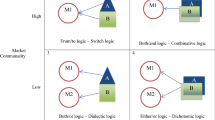Abstract
Recent developments in organization theory about arrangements that are neither markets nor hierarchies provide an opportunity to reconsider the nature of cooperatives and their fundamental characteristics. The concept of “hybrids” developed by transaction cost economics to encapsulate the properties of these arrangements may be particularly relevant in that it provides a theoretical framework in which to embed cooperatives among other modes of governance. This paper goes in that direction and proposes a characterisation of different regimes among cooperatives, establishing a typology grounded in theory. An important result of this approach is that it challenges standard competition policies towards cooperatives.
Access this chapter
Tax calculation will be finalised at checkout
Purchases are for personal use only
Preview
Unable to display preview. Download preview PDF.
Similar content being viewed by others
References
Alchian, A.A. and H. Demsetz. 1972. “Production, Information Costs and Economic Organization.” American Economic Review 62(5):777–795.
Bonus, H. 1986. “The Cooperative Association as a Business Enterprise: a Study in the Economics of Transactions.” Journal of Institutional and Theoretical Economics 142(3):310–399.
Brickley, J. A. and F. H. Dark. 1987. “The Choice of Organizational Form: the Case of Franchising”. Journal of Financial Economics 18(2):401–420.
Coase, R. H. 1998. “New Institutional Economics.” American Economic Review 88(2):72–74.
Cook, M.L. 1995. “The Future of US Agricultural Cooperatives: A Neo-institutional Approach.” American Journal of Agricultural Economics 77:1153–1159.
Cook, M.L. and C. Iliopoulos. 2000. “Ill-defined Property Rights in Collective Action: The Case of US Agricultural Cooperatives.” In C. Mènard, ed. Institutions, Contracts and Organizations. Perspectives from New Institutional Economics. Cheltenham: E. Elgar, pp. 335–348.
Cook, M.L., F. R. Chaddad, and C. Iliopoulos. n.d. “Advances in Cooperative Theory since 1990: A Review of Agricultural Economics Literature”. Working Paper, University of Missouri-Columbia.
Eccles, R. 1981. “The Quasifirm in the Construction Industry.” Journal of Economic Behavior and Organization 2(4):335–357.
Gibbons, R. 2003. “Team Theory, Garbage Cans and Real Organizations: Some History and Prospects of Economic Research on Decision-making in Organizations.” Industrial and Corporate Change 12(4):753–797.
Grandori, A. and G. Soda. 1995. “Inter-firm Networks: Antecedents, Mechanisms and Forms.” Organization Studies 16(2):183–214.
Greif, A. 1993.”Contract Enforceability and Economic Institutions In Early Trade: The Maghribi Traders.” American Economic Review 83(3):525–547.
Hansmann, H. 1988. “The Ownership of the Firm.” Journal of Law, Economics and Organization4(2):267–304.
Hendrikse, G.W.J. and C.P. Veerman. 2001. “Marketing Cooperatives: An Incomplete Contract Perspective.” Journal of Agricultural Economics 52(1):53–64.
Hendrikse, G.W.J. and W.J.J. Bijman. 2002. “Ownership Structure in Agrifood Chains: The Marketing Cooperative.” American Journal of Agricultural Economics 84(1):104–119.
Joskow, P. 1988. “Asset Specificity and the Structure of Vertical Relationships.” Journal of Law, Economics and Organization 4(1):95–117.
Joskow, P. 2005. “Vertical Integration.” In C. Mènard and M. Shirley, eds. Handbook of New Institutional Analysis. Springer, pp. 319–348.
Klein, P. 2005. “The Make-or-Buy Decisions. Lessons from Empirical Studies.” In C. Mènard and M. Shirley, eds. Handbook of New Institutional Analysis. Springer, pp. 435–464.
Lafontaine, Francine and Kathrin Shaw (1999) “The Dynamics of Franchise Contracting: Evidence from Panel Data.” Journal of Political Economy. 107:1041–1080.
Marshall, A. 1920. Principles of Economics. 8th ed. London: MacMillan. Reprint 1969
Ménard, C. 1996. “On Clusters, Hybrids and other Strange Forms. The Case of the French Poultry Industry.” Journal of Institutional and Theoretical Economics 152(1):154–183.
Ménard, C. 2004. “The Economics of Hybrid Organizations.” Journal of Institutional and Theoretical Economics 160(4):345–376.
Ménard, C. 2005a “A New Institutional Approach to Organization.” In C. Mènard and M. Shirley, eds. Handbook of New Institutional Analysis. Springer, pp. 281–318.
Ménard, C. 2005b. “The Inadequacy of Competition Policies: A New Institutional Approach.” In M. Oppenheimer and N. Mercuro, eds. Law and Economics: Alternative Economic Approaches to Legal and Regulatory Issues. New York: M.E. Sharpe, pp. 27–54.
Ménard, C. 2005c. “Oliver Williamson and the Economics of Hybrid Organizations.” in M. Augier, J. March and D. Teece (eds.), Title not yet determined, Oxford: Oxford University Press, in press.
Ménard, C. 1997/2005. “Le Pilotage des Formes Organisationnelles Hybrides”, Revue Economique 48(2):741–751. English translation: “The Governance of Hybrid Organizational Forms.” In C. Mènard, ed. The International Library of New Institutional Economics. Cheltenham: Edward Elgar, vol. IV, pp. 105– 113.
Ménard, C. and M.M. Shirley. 2005. Handbook of New Institutional Economics, Berlin-Boston-Dordrecht-New York: Springer.
Ménard, C. and E. Valceschini. 2005. “Institutions for Governing Agriculture and Rural Areas.” European Review of Agricultural Economics, in press.
Palay, T.M. 1985. “Avoiding Regulatory Constraints: Contracting Safeguards and the Role of Informal Agreements.” Journal of Law, Economics, and Organization 1(1):155–175.
Powell, W. 1996. “Inter-organizational Collaboration in the Biotechnology Industry.” Journal of Institutional and Theoretical Economics 152(1):197–215.
Raynaud, E. 1997. Propriètè et exploitation partagèe d’une marque commerciale: alèas contractuels et ordre privè. PhD dissertation, Universitè de Paris (Panthèon-Sorbonne).
Riordan, M. and O. Williamson. 1985. “Asset Specificity and Economic Organization. ”International Journal of Industrial Organization 3(5):365–378.
Rubin, P. H. 1978. “The Theory of the Firm and the Structure of the Franchise Contract.” Journal of Law and Economics 21(1):223–234.
Sauvée,L. 1997. “Managing a Brand in the Tomato Sector: Authority and Enforcement Mechanisms in a Collective Organization.” Acta Horticulturae 536:537–554
Sauvée,L. 2002. “Governance in Strategic Networks.” Working Paper, ISAB: Beauvais.
Staatz, J. M. 1989. Farmer Cooperative Theory: Recent Developments. Washington DC: U.S. Department of Agriculture, ACS Agr. Coop. Service Research Rep. 84.
Stinchcombe, A. 1990. Information and Organizations. Berkeley: University of California Press.
Thorelli, H.B. 1986. “Networks: Between Markets and Hierarchies.” Strategic Management Journal 7(1):37–51.
Williamson, O.E. 1991. [1996] “Comparative Economic Organization: The Analysis of Discrete Structural Alternatives.” Administrative Science Quarterly 36(2):269–296. Reproduced in The Mechanisms of Governance. Oxford: Oxford University Press.
Williamson, O.E. 1985. The Economic Institutions of Capitalism. New York: The Free Press-Macmillan.
Author information
Authors and Affiliations
Rights and permissions
Copyright information
© 2007 springer
About this chapter
Cite this chapter
Ménard, C. (2007). Cooperatives: Hierarchies or Hybrids?. In: Vertical Markets and Cooperative Hierarchies. Springer, Dordrecht. https://doi.org/10.1007/1-4020-5543-0_1
Download citation
DOI: https://doi.org/10.1007/1-4020-5543-0_1
Publisher Name: Springer, Dordrecht
Print ISBN: 978-1-4020-4072-6
Online ISBN: 978-1-4020-5543-0
eBook Packages: Business and EconomicsEconomics and Finance (R0)




